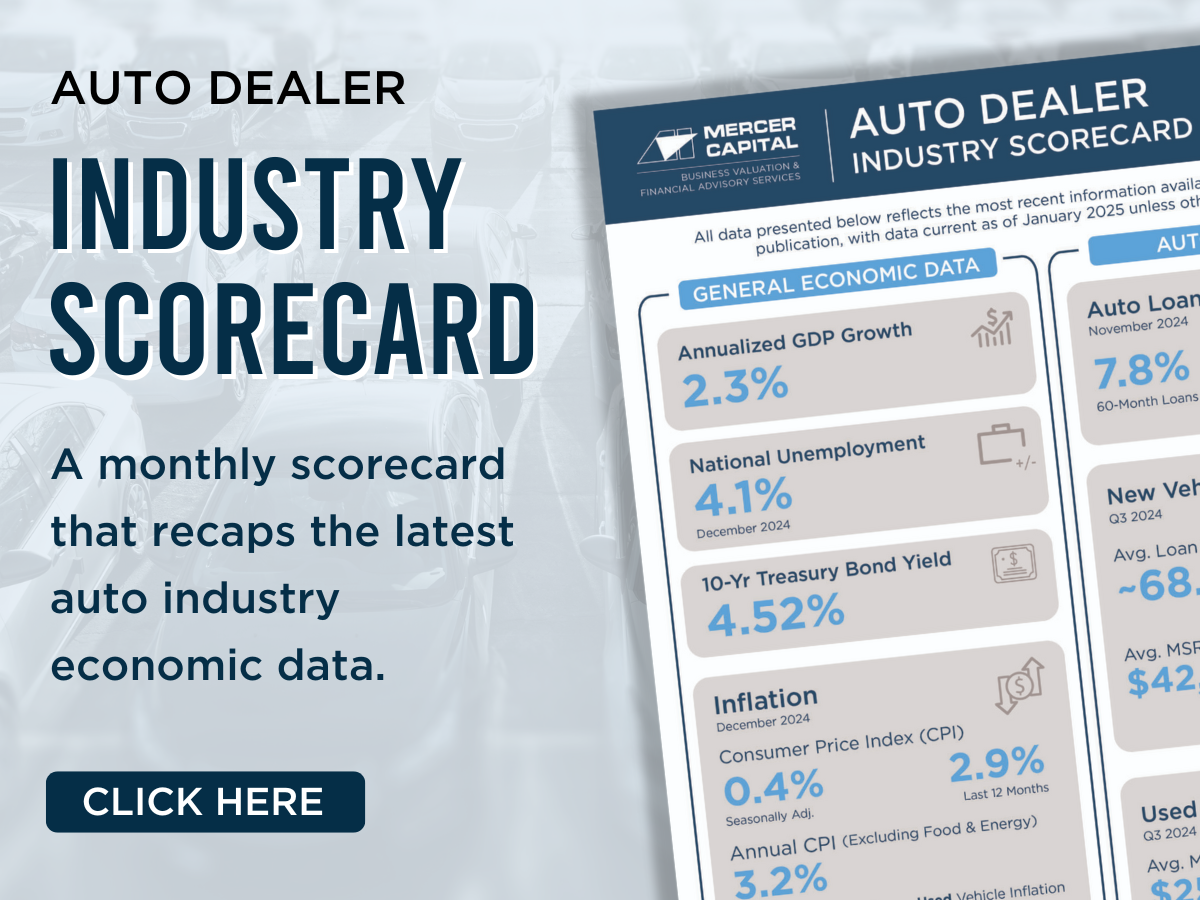It has become a tradition for the Auto Dealer team at Mercer Capital to end the blog year with a “unique” summary of industry events, riffing off Clement Clark Moore’s classic “A Visit from St. Nicholas.” We hope all of you enjoy the holiday season. We look forward to hearing from you in 2024.
Category
Special Topics
Auto Dealer Insights: Best of 2023
As we put a bow on 2023, we’re looking back at our top posts from the year. Our weekly posts follow the auto industry closely to keep up with market trends and gain insight into the private dealership market. We hope you have enjoyed our content in 2023, and we look forward to connecting further in 2024!
Return to Status Quo or a New Normal?
Auto Leasing Trend Update
In the evolving landscape of vehicle transactions, consumers have veered away from leasing due to factors like inventory shortages, higher interest rates, and less attractive leasing incentives. Despite this shift, leasing remains a cheaper option than buying, with dealers and manufacturers closely monitoring the market’s changing dynamics. As leasing shows signs of recovery in 2023, its future in the auto industry hinges on factors like market trends, consumer behavior, and effective dealership strategies.
Key Takeaways for Auto Dealers from the 2023 AICPA Dealership Conference
Last month, we attended the 2023 AICPA Dealership conference and in this post present key takeaways on two sessions that are of interest to our blog readers: “Driving Success in Auto Retail” and “The Electrification of Auto Retail.”
Newly Released: Auto Dealer Video Series
Mercer Capital’s Scott Womack had the pleasure of being invited to record a series of videos created by the Rawls Group, where he talked with partner and succession advisor Dan Iosue. Get to know what both Dan and Scott do best as they talk about everything from the best timing for valuations to how to successfully negotiate business disputes in the auto industry.
Just Released: Mid-Year 2023 Auto Dealer Industry Newsletter
We are pleased to release our latest edition of Value Focus: Auto Dealer Industry Newsletter.
United Auto Workers Strike
What It Means for Auto Dealers
The United Auto Workers (UAW) strike has been ongoing for almost a month now. In this post, we talk about how we got here, updates on the strike, and the strike’s anticipated impact on auto dealers.
The Winding Road to Blue Sky Value
Important Considerations in Auto Dealer Valuations and Pitfalls to Avoid
In the upcoming month, Scott Womack and David Harkins will present at three different forums, shedding light on the pivotal aspects and considerations of auto dealer valuations, including special considerations in litigation/buy-sell matters. They will delve into why traditional market approaches are generally not applicable for the valuation of auto dealerships, especially single rooftop operations, and explore the limitations of existing database evaluations. Beyond this, they will also explore the changing dynamics of value drivers like real estate and employee management, highlighting the shifting landscape as the industry moves towards digital and online platforms, and offer insights and suggestions for navigating buy/sell litigation and ensuring fair and consistent transactions.
Toyota’s Steady State Battery
Breakthrough or Yet Another Long-Dated Production Target?
In early July, Financial Times reported Toyota’s solid-state battery breakthrough. According to Keiji Kaita, president of Toyota’s research and development center for carbon neutrality, the goal is to cut the size, weight, and cost of both liquid and solid-state batteries in half. In this post, we get into the details of this report, what auto dealers should know about solid-state batteries, and provide some context for realistic expectations.
Mid-Year 2023 Review of the Auto Dealer Industry by Metrics
Cooling Statistics, But Perspective Is Key
The first half of 2023 has been successful for auto dealers despite a decline in some metrics from previous record highs, according to recent industry reports. Although new vehicle profitability has experienced a reduction compared to the end of 2021, it’s still notably higher than pre-pandemic levels. In this blog, we provide a deep dive into key indicators such as new vehicle supply, average trade-in equity values of used vehicles, and vehicle miles traveled to give a comprehensive view of the current auto industry trends.
Tax Planning for Auto Dealerships
Why Auto Dealers Might Not Pay “Market” Rent
In business valuation, appraisers seek to normalize historical earnings to establish the level of earnings an investor might reasonably expect from an investment in the subject company. These adjustments may increase or decrease earnings, and they can be for a variety of reasons. Normalization adjustments include surveying various expense categories and determining whether the amount historically paid is considered “market rate.”
Rent paid to a related party is frequently judged to be above or below market, which can be for a variety of reasons. Dealers’ priorities lie more with sales and operating efficiency than tracking what the market says they should pay in rent. The rent paid also may be artificially high or low for tax purposes. In this post, we examine what exactly this means, and why auto dealers may hold real estate in a separate but related entity from the one that owns the dealership operations.
Overview of Auto Finance 2023
Origination, Delinquency, and Portfolio Trends
Explore the shifting landscape of auto finance as we compare the roles of captive finance companies and third-party lenders, track current market trends, and analyze credit quality and interest rates. From assessing the changing face of dealership profitability to exploring the increasing importance of finance and insurance departments, we offer our perspective on the industry’s present and potential future.
Demise of the Sedan
Does Recent Data Suggest the Sedan Will Follow the Station Wagon and Minivan?
Do you remember the infamous car from National Lampoon’s Vacation? As the inspiration for this week’s blog, we explore how cars have evolved from the ‘family truckster’ station wagons of the 70s and 80s to the rise of SUVs and crossovers today. Leveraging recent data and vehicle trends, we look at whether the once-popular sedan is being phased out or if it could potentially make a comeback. We also consider the influence of historical legislation on vehicle trends and potential future shifts that may once again place the sedan in the limelight.
Infrastructure Investment for EVs, Data Privacy, and Dealership Buy-Back Programs
2023 NADC Conference Update
The recent NADC conference unveiled many developments that are shaking up the auto dealer industry. Unpacking the evolving shift towards electric vehicles (EVs), we heard about infrastructure investments and the legal labyrinth posed by new EV-specific brands. As technology in vehicles leaps forward, we also learned the challenges of data privacy and consumer data protection laws. And for those dealers hesitant about the EV transition, dealership buyback programs may be on the table. These issues, among others, are steering the future course of the auto industry, demanding a watchful eye. Discover how these evolving landscapes could impact you.
Middle Men: Family-Owned Auto Dealerships
As an auto dealer, you may be wondering what is my dealership worth? In this video, Scott Womack discusses the key value drivers of an auto dealership.
EV Potpourri
Discussing Levels of Charging to OEM Requirements of Dealers
There are exciting developments in the electric vehicle (EV) market, where sales momentum continues to build as EVs make up an increasing share of new light-duty vehicle sales. Learn about the different charging levels, the various requirements automakers have for their dealers, and the expanding presence of charging stations at various retailers and restaurants. As major auto manufacturers are investing in and adapting to the EV revolution, sustainable transportation appears to be the way forward in this rapidly growing industry.
Plan for the Unexpected
Succession Planning for Auto Dealers
The 2023 NCAA College Basketball Tournament began last week. Many of us have been checking our brackets obsessively. There’s a reason it’s called March Madness. Who would have predicted that Fairleigh Dickinson would upset Purdue or that Princeton would upset Arizona and advance to the Sweet 16? The tournament and its bracket challenges are full of possibilities but are also a source of frustration, given the unexpected twists and turns. In certain ways, succession planning for auto dealers mirrors the journey through the tournament. Just as the thought of a #16 seed beating a #1 seed wasn’t on our radars before 2018 (when #16 University of Maryland-Baltimore County beat #1 Virginia 74-54 on March 16, 2018), thoughts of a global pandemic or an inventory crisis caused by a microchip shortage weren’t expected either. The lesson to be learned: Plan for the unexpected.
In this post, we discuss some of the key factors to be considered in the succession planning process and why they are critical.
2022 Auto Dealer Industry Metrics Review
Has Profitability Peaked?
As we turn the calendar to March, 2022 is in the rearview mirror, and year-end statistics for the auto industry have been released. How did the industry perform, and what do the metrics tell us about the direction of the industry in 2023? In this post, we discuss the key metrics we track for the industry: new vehicle profitability, the supply of new vehicles, average trade-in equity values of used vehicles, the used-to-new vehicle retail unit sales ratio, fleet sales, and vehicle miles traveled.
Floorplan Interest Income Fading
Part 1: Rising Interest Rates and Increasing Inventories Are Anticipated to Remove the Unlikely Profit Center
Compared to last year, interest rates have significantly increased since the Federal Reserve began raising rates in March 2022. Inventories have also improved as the industry works through its supply chain issues. These shifts in economic trends are expected to have an impact on many aspects of auto dealer operations. In this week’s post, we talk about floorplan interest income and pose some important questions: What is floorplan interest expense, and what are floorplan credits? How have floorplan credits turned into an unlikely profit center for dealers? Can we expect this trend to continue amid changing conditions?
Auto Industry Trends to Monitor in 2023
An Automotive Potpourri
January is a month to review statistics from the prior year and to make predictions for the new year. The automobile industry is no different. In this post, we tackle a potpourri of trends to monitor in 2023, including new and used vehicle prices, electric vehicles, connected cars, and SAAR predictions for 2023.
‘Twas the Blog Before Christmas…
2022 Mercer Capital Auto Dealer Holiday Poem
It has become a tradition for the Auto Dealer team at Mercer Capital to end the blog year with a “unique” summary of industry events, riffing off Clement Clark Moore’s classic “A Visit from St. Nicholas.” We hope all of you enjoy the holiday season. We look forward to hearing from you in 2023.
The Top 2022 Blog Posts from Auto Dealer Valuation Insights
Despite existing operational headwinds and new economic headwinds in 2022, auto dealers continued to produce record profits. As we wind down the year and look towards next year, we look back to see what was popular with you—our loyal readers. Here are some of your favorite posts from 2022.
Auto Brands and the 2022 World Cup
Who Are the Top Ranked Countries?
This week we compare the FIFA rankings of the world’s largest vehicle producing countries. Spoiler alert: there is no correlation. But in our research, we found plenty of interesting nuggets and talking points. We also discuss top vehicle producing nations that did not qualify for the World Cup, nations that did qualify but do not have a large presence in auto production. We also get into brand presence and Blue Sky multiples of these nations’ vehicle brands.
Meet the Team
Harrison Holt
In each “Meet the Team” segment, we highlight a different professional on our Auto Dealer Industry team. This week we highlight Harrison Holt, Financial Analyst. We hope you enjoy getting to know us a bit better.










